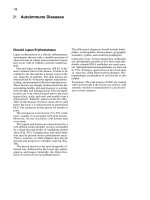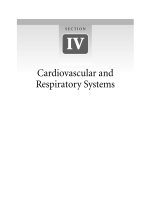Ebook Surgical diseases: Part 2
Bạn đang xem bản rút gọn của tài liệu. Xem và tải ngay bản đầy đủ của tài liệu tại đây (8.48 MB, 127 trang )
166 / Surgical Diseases
FIGURE 8.1: Amebic liver abscess
FIGURE 8.2: Amebic liver
abscess-Anchovy sauce
pus
Amebic liver abscess is common in India and other tropical
countries and is caused by Entamoeba histolytica.
Commonly it is single large abscess in right lobe but often
can be multiple. Pus is chocolate colored, anchovy-sauce
type. Often abscess can be secondarily infected by bacteria.
Right sided pleural effusion is known to occur. It can be
acute or chronic or can be calcified. Amebic liver abscess
can rupture into peritoneum, lung, pericardium or into intestine
which often can be fatal. Treatment is antiamebic drugs like
metronidazole, chloroquine, U/S guided aspiration or open
drainage.
Liver and Gallbladder / 167
FIGURE 8.3: Massive
ascites
FIGURE 8.4: Caput medusae
Portal hypertension due to cirrhosis can cause massive
ascites. It is due to increased portal pressure, altered
aldosterone mechanism, lymphatic blockage or hypoproteinemia. Caput medusae is dilatation of veins around
the umbilicus due to communication between paraumbilical
and anterior abdominal veins.
168 / Surgical Diseases
FIGURE 8.5: Hydatid cyst of the liver
Hydatid cyst of the liver is caused by Echinococcus
granulosus. It attains a large size slowly over few years.
Three finger hydatid thrill may be positive. Pain and jaundice
can occur. If cyst ruptures anaphylaxis can develop. U/S is
diagnostic. Praziquantel and albendazole are useful.
Cetrimide and hypertonic saline are the scolicidal agents
used for hydatid cyst. During surgery spillage of scolices
should be avoided as it may lead into development of
secondary hydatids elsewhere. Colored mops are placed in
the peritoneal cavity to identify the spilled scolices.
Liver and Gallbladder / 169
FIGURE 8.6: Endoscopic view of
varices
FIGURE 8.7: SengstakenBlakemore tube in situ
Oesophageal varices due to portal hypertension are graded
based on size and luminal prolapse. Acute bleeding is
controlled by Sengstaken Blakemore tube in place. It can
be kept in place for 72 hours. Recurrent bleeding is controlled
by sclerotherapy, endoscopic variceal banding and
endoscopic intravariceal injection of Butyl-cyanacrylate
(glueing) (most often for gastric varices). Shunt surgeries
are not commonly used for acute variceal bleed.
170 / Surgical Diseases
FIGURE 8.8: CT picture of hepatoma
CT scan picture of hepatocellular carcinoma (hepatoma).
Hepatoma is common in patients with cirrhosis and hepatitis
B and hepatitis C infection. It is unicentric and right lobe is
commonly involved. Painless large palpable liver which is
smooth, hard, nontender are the features. Hepatic bruit,
ascites and jaundice may develop later. CT scan is a must.
Early case is treated by hemihepatectomy. Chemotherapy
with adriamicin is useful. Hepatic artery ligation, intra arterial
chemotherapy are other modalities available.
Liver and Gallbladder / 171
FIGURE 8.9: CT picture of secondaries in liver
CT picture of the abdomen showing multiple liver secondaries
in both lobes. Common sites of primary to cause liver
secondaries are stomach, colon, pancreas, small bowel.
Extraabdominal conditions like carcinoma breast, melanoma
or carcinoma kidney can also cause liver secondaries. Liver
secondaries are multiple, hard, nodular and umbilicated due
to central necrosis.
172 / Surgical Diseases
FIGURE 8.10: CT picture of hydrohepatosis
In severe obstructive jaundice there will be dilatation of intrabiliary radicles along with the dilatation of extra biliary
radicles. Liver will be soft, smooth called as hydrohepatosis.
Common causes are growth in the pancreas, in the CBD
and Klatskin tumor.
Liver and Gallbladder / 173
FIGURE 8.11: U S showing roundworm in the gallbladder
Roundworm from the intestine occasionally can creep into
the CBD and gallbladder across sphincter of Oddi to cause
acute cholangitis and acute cholecystitis. Figure shows
roundworm in gallbladder. Patient presented with features of
acute cholecystitis and needed cholecystectomy.
174 / Surgical Diseases
FIGURE 8.12: U S showing stones in the gallbladder
Figure shows ultra-sound picture of stones in the gallbladder.
Gallbladder with stones and post-acoustic shadow is obvious.
Patient requires cholecystectomy (laparoscopic or open).
Liver and Gallbladder / 175
FIGURE 8.13A: Chronic cholecystitis with
multiple gall stones—on table
FIGURE 8.13B: Multiple gall stones with
thickened gallbladder due to cholecystitis
176 / Surgical Diseases
FIGURE 8.13C: Gall stones
with thickened gallbladder
FIGURE 8.13D: Solitary gall stone
with thickened cholecystitic
gallbladder
Gall stones are common in females. It may be cholesterol
stone mixed stones or pigment stones. Causes are metabolic,
bile stasis, increased bilirubin production or drug related.
Presents as biliary colic, acute / chronic cholecystitis, and
CBD stone with acute cholangitis or pancreatitis. U/S is diagnostic. To confirm or rule out CBD stones CT scan or ERCP
is essentially done. Treatment is laparoscopic cholecystectomy. If CBD stones are present, ERCP and stone extraction
should be done prior to laparoscopic cholecystectomy. If ERCP
is not possible then open cholecystectomy with CBD exploration for stone extraction must be done. Occasionally
choledochoduodenostomy or choledochojejunostomy may be
required.
Liver and Gallbladder / 177
FIGURE 8.14: T tube in the CBD after choledochotomy
For gall stones along with CBD stone, after cholecystectomy,
choledochotomy is done. Indications are CBD diameter more
than 1 cm, recent history of jaundice, on table palpable CBD
stone, US showing CBD stone, on table cholangiogram
showing CBD stone or when in doubt. Once choledochotomy
is done CBD stone is extracted using Des’jardin’s
choledocholithotomy forceps. CBD is then closed by placing
a T tube which is kept for 10-14 days. After doing T tube
cholangiogram, T tube is removed.
178 / Surgical Diseases
FIGURE 8.15: Sclera in obstructive surgical jaundice
Obstructive jaundice is commonly due to CBD growth, CBD
stone, carcinoma pancreas, Klatskin tumor, extrinsic
compression or parasitic infestations. Patient presents with
severe jaundice, pruritus, fever, loss of appetite or weight.
LFT, US abdomen, CT scan are the required investigations.
Treatment depends on condition. For CBD stones CBD
exploration is needed. For carcinoma pancreas, Whipple’s
operation is done. ERCP and stenting is often needed as
initial method to decompress the biliary tree.
180 / Surgical Diseases
FIGURE 9.1: Acute pancreatitis—on table finding
Acute pancreatitis is often life threatening condition.
Common cause is biliary stone disease. It is classified as
acute interstitial pancreatitis and acute necrotizing
pancreatitis. Second type is further classified as sterile
necrosis and infected necrosis. Infected necrosis has got
high mortality rate. Hemorrhagic necrosis with ‘chicken broth’
fluid is typical. Presents with sudden severe pain often after
an alcohol intake which radiates towards back, slightly
Pancreas and Spleen / 181
reduces by kneeling forward and so patient prefers to stay
in that position. Abdomen features mimic acute abdomen
with toxicity. Complications like ARDS, respiratory failure,
septicemia, DIC, pancreatic ascites and pseudocyst
formation can develop. Treatment is commonly conservative.
CT scan is ideal and diagnostic. Serum amylase is
commonly done. Serum lipase is more sensitive. Serum
trypsin assay is the best. US is done to look for gall stones.
Bilthzar scoring system on CT is commonly used. Surgery
and debridement is done when condition deteriorates, when
necrosis is severe and when diagnosis is in doubt.
Necrotizing pancreatitis has got high mortality rate.
182 / Surgical Diseases
FIGURE 9.2: CT picture of
pseudocyst of pancreas
FIGURE 9.3: On table aspiration
of pseudocyst, note the brownish color
Pseudocyst can be communicating or non-communicating.
Presents as a swelling in epigastric region which is smooth,
does not move with respiration, nonmobile, pulsatile
{disappears on knee-elbow position}, resonant or impaired
resonant on percussion. CT scan is the study of choice. US
is commonly done. Cyst should be formed with thick wall
and should be more than 6 cm in size to treat surgically.
Surgical treatment is cysto-jejunostomy/cystogastrostomy.
Pancreas and Spleen / 183
FIGURE 9.4: X-ray showing pancreatic calcification
FIGURE 9.5: Pancreatic stone—specimen
Chronic calcifying pancreatitis can be parenchymal calcification as shown in X-ray or ductal stone as shown in Figure
9.5 specimen. Ductal stone is better than parenchymal
calcification. Presents with pain, exocrine insufficiency,
diabetes mellitus. Treatment for parenchymal calcification
is total pancreatectomy. Stone in the duct is removed with
pancreatico-jejunostomy.
184 / Surgical Diseases
FIGURE 9.6: CT picture showing pancreas with dilated CBD
In periampullary growth and carcinoma head of the pancreas
CBD will be dilated with hydrohepatosis. CT scan is done to
see the operability of the tumor. If operable, pancreaticoduodenectomy is done.
Pancreas and Spleen / 185
FIGURE 9.7: Whipple’s operation—specimen
Specimen of pancreaticoduodenectomy showing gallbladder,
C loop of duodenum, distal stomach and head of the pancreas
with tumor. It is done for periampullary carcinoma or
carcinoma head of pancreas. Operability is assessed by
CT scan. On table adequate plane should be developed
between portal vein and neck of the pancreas to confirm it
as operable. After resection, choledochojejunostomy,
pancreatico-jejunostomy and gastrojejunostomy are done.
186 / Surgical Diseases
FIGURE 9.8: CT picture of cystadenocarcinoma of pancreas
Cystadenocarcinoma of pancreas occurs commonly in body
and tail of pancreas. It attains large size and presents as
backpain with retroperitoneal mass in epigastric region.
Jaundice is uncommon in cystadenocarcinoma of pancreas.
CT is conclusive. Treatment is distal pancreatectomy. It has
got better prognosis when compared with carcinoma head
of pancreas.
Pancreas and Spleen / 187
FIGURE 9.9: Splenic injury—on table
Figure shows lacerated wound over the spleen which required
splenectomy. Splenorrhaphy can be done in clean incised
wound especially in children so as to save the spleen. Other
option is partial splenectomy. Patient should receive
pneumococcal vaccine to prevent the possible chances of
OPSI (Overwhelming Post Splenectomy Infection). OPSI
has got high mortality.
188 / Surgical Diseases
FIGURE 9.10A: ITP
showing purpura in
legs
FIGURE 9.10B: ITP
showing purpura in leg
ITP {Idiopathic thrombocytopenic purpura} is an acquired
condition; due to formation of antiplatelet antibodies
damaging patient’s own platelets. It can be acute or chronic.
It is common in young females. Presents with bleeding
tendency which is often life threatening. Spontaneous
regression can occur in many cases. Methylprednisolone,
prednisolone, danazol, azathioprine, immunoglobulins,
vincristine, antiRh antibodies, FFP or splenectomy are
therapeutic options.
Pancreas and Spleen / 189
FIGURE 9.11: Splenic tuberculosis—specimen
Tuberculosis of spleen is rare. It is often associated with
immunosuppression or diabetes. Secondary infection can
occur leading into fulminant sepsis. Primary focus may be
there in the lungs. Treatment is antituberculous drugs with
guided aspiration of pus or splenectomy.









